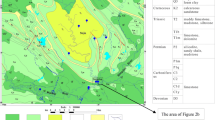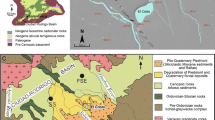Abstract
The chemistry of surface water sampled at different locations of the Kolleru Lake in Andhra Pradesh (India) show heterogeneous variability. The concentrations of dissolved sodium and chloride ions, total dissolved solids (TDS) together with high conductivity documented in water samples are indicative of mixing of saline seawater. This interpretation is further corroborated by enriched δ18O compositions of the carbonate fraction of the surface sediments collected at the same locations (as that of water) of the lake, and fairly good positive correlations of δ18O –Na+ and δ18O–TDS. The saline water intrusion into the lake appears to be resulted due to its near stagnant to dry condition with reduced inflow and outflow. Such dry condition facilitated seawater intrusion into the lake due to several reasons: (i) proximity of lake to the sea (~35 km), (ii) overexploitation of fresh groundwater for agriculture as well as livestock farming, and (iii) incursion of tidal seawater (high sea waves) through Upputeru River, which is directly linked to the sea. We also document highly heterogeneous distribution of certain potentially toxic metal ions like chromium, copper, manganese, and zinc in the lake waters. Indiscriminate disposal of domestic and industrial effluents around the lake appears to be responsible for the presence of potentially toxic heavy metals. Based on these results, we finally suggest some measures for environmental rehabilitation of the lake and its surroundings.






Similar content being viewed by others
References
Amaraneni, S. R. (1997). Studies on pollution problems of Kolleru lake with special reference to pesticides, polycyclic aromatic hydrocarbons and heavy metals. unpublished Ph.D. Thesis, Andhra University, Vishakapatnam, India.
Amaraneni, S. R., & Pillala, R. R. (2000). Environmental impact of aquaculture on Kolleru lake. Indian Journal of Environment and Toxicology, 10, 1–4.
Amaraneni, S. R., & Pillala, R. R. (2001a). Concentration of pesticide residue in tissues of fish from Kolleru lake, India. Environmental Toxicology, 16, 550–556.
Amaraneni, S. R., & Pillala, R. R. (2001b). Heavy metal concentrations in the sediments from Kolleru Lake, India. Indian Journal of Environmental Health, 43, 148–153.
APHA (1995). Standard methods for the examination of water and wastewater (19th ed.). Washington, D. C.: American Public Health Association.
Azeez, P. A., Ashok Kumar, S., Choudhury, B. C., Sastry, V. N. V. K., Upadhyay, S., Reddy, K. M., et al. (2011). Report on the proposal for downsizing the Kolleru Wildlife Sanctuary (+5 to +3 feet contour). Government of India: Submitted to the Ministry of Environment and Forests www.thehindu.com/multimedia/.../Kolleru_Report9Apri_549380a.pdf, Accessed 02 June 2016.
Banens, R. J. (1987). The geochemical character of upland waters of northeast New South Wales. Limnology and Oceanography, 32, 1291–1306.
Biksham, G. (1985). Geochemistry of the Godavari river basin. unpublished Ph.D. Thesis, Jawaharlal Nehru University, New Delhi, India.
Chandra Sekhar, K., Chary, N. S., Kamala, C. T., Raj, D. S., & Rao, A. S. (2003). Fractionation studies and bioaccumulation of sediment-bound heavy metals in Kolleru lake by edible fish. Environment International, 29, 1001–1008.
Cheng, S. (2003). Heavy metals in plants and phytoremediation. Environmental Science and Pollution Research, 10(5), 335–340.
Dahdouh-Guebas, F., Collin, S., Lo Seen, D., Rönnbäck, P., Depommier, D., Ravishankar, T., et al. (2006). Analysing ethnobotanical and fishery-related importance of mangroves of the East-Godavari Delta (Andhra Pradesh, India) for conservation and management purposes. Journal of Ethnobiology and Ethnomedicine, 2(1), 24. doi:10.1186/1746-4269-2-24.
Dhote, S., & Dixit, S. (2009). Water quality improvement through macrophytes—a review. Environmental Monitoring and Assessment, 152, 149–153. doi:10.1007/s10661-008-0303-9.
Durga Prasad, M. K., & Anjaneyulu, Y. (2003). Lake Kolleru: environmental status (past and present). Hyderabad, India: B. S. Publishers ISBN : 8178000466.
Freeze, R. A., & Cherry, J. A. (1979). Groundwater, Prentice Hall Inc (p. 604). New Jersey.
Gibbs, R. J. (1970). Mechanism controlling world water chemistry. Science, 170, 1088–1090.
Grottoli, A. G., Rodrigues, L. J., Matthews, K. A., Palardy, J. E., & Gibb, O. T. (2005). Pre-treatment effects on coral skeletal delta13C and delta18O. Chemical Geology, 221, 225–242.
Gupta, S. C., Rathore, G. S., & Mathura, G. C. D. (2001). Hydro-chemistry of Udaipur lakes. Indian Journal of Environmental Health, 43, 38–44.
Gupta, S. K., & Deshpande, R. D. (2003). Synoptic hydrology of India from the data of isotopes in precipitation. Current Science, 85, 1591–1595.
Gupta, S. K., & Deshpande, R. D. (2005). The need and potential applications of a network for monitoring of isotopes in waters of India. Current Science, 88, 107–118.
Hendy, C. (1971). The isotopic geochemistry of speleothems—I The calculation of the effects of different modes of formation on the isotopic composition of speleothems and their applicability as palaeoclimatic indicators. Geochimica et Cosmochimica Acta, 35, 801–824. doi:10.1016/0016-7037(71)90127-X.
Iwasaki, S., & Shaw, R. (2009). Linking human security to natural resources: perspective from a fishery resource allocation system in Chilika lagoon, India. Sustainability Science, 4(2), 281–292. doi:10.1007/s11625-009-0084-2.
Kilham, P. (1990). Mechanisms controlling the chemical composition of lakes and rivers, data from Africa. Limnology and Oceanography, 35, 80–83.
Koppolu, L., Prasad, R., & Clements, L. D. (2004). Pyrolysis as a technique for separating heavy metals from hyperaccumulators. Part III: pilot-scale pyrolysis of synthetic hyperaccumulator biomass. Biomass and Bioenergy, 26, 463–472.
Langmuir, D. (1997). Aqueous environmental geochemistry (p. 600). New Jersey: Prentice Hall.
Lehmann, J. (2007). Bioenergy in the black. Frontiers in Ecology and the Environment, 5, 381–387.
Manning, J. C. (1997). Applied principles of hydrology (p. 276). New Jersey: Prentice Hall.
Martin, J. M., & Lettole, R. (1979). Oxygen 18 in estuaries. Nature, 282, 292–294.
McCrea, J. M. (1950). On the isotopic chemistry of carbonates and a paleotemperature scale. The Journal of Chemical Physics, 18, 849–857.
McKenzie, J. A. (1985). Carbon isotopes and productivity in the lacustrine and marine environment. In W. Stumn (Ed.), Chemical process in lakes (pp. 99–118). New York: Wiley.
Naidu, T. A. (2015). Mass burial of dead fish in Kolleru Lake intensified. http://www.thehindu.com/news/national/andhra-pradesh/mass-burial-of-dead-fish-inkolleru-lake-intensified/article7170086.ece. Accessed 21 December 2015.
Pattanaik, C., Prasad, S. N., Nagabhatla, N., & Finlayson, C. M. (2008). Kolleru regains its grandeur. Current Science, 94, 9–10.
Nagabhatla, N., & Sellamuttu, S. S. (2008). Political ecology of wetland management: the post aquaculture demolition case of Lake Kolleru in India. Revista Geográfica Acadêmica, 2(1), 10–19.
Ramesh, R. (1985). Geochemistry of Krishna river basin. unpublished Ph.D. Thesis, Jawaharlal Nehru University, New Delhi, India.
Rao, K. N., Krishna, G. M., & Hema Malini, B. (2004). ‘Kolleru lake is vanishing—a revelation through digital processing of IRS-1D LISS-III sensor data. Current Science, 86, 1312–1316.
Rao, K. N., Naga Kumar, K. C. V., Subraelu, P., Demudu, G., Reddy, B. V., & Hema Malini, B. (2010). Kolleru lake revisited: the post “operation Kolleru” scenario. Current Science, 98, 1289–1291.
Samal, K., & Meher, S. (2003). Fishing communities on Chilika Lake: comparative socio-economic study. Economic and Political Weekly, 38(31), 3319–3325.
Sarkar, A., Ramesh, R., & Bhattacharya, S. K. (1990). Effect of sample pretreatment and size fraction on the ð13C and ð18O values of foraminifera in Arabian Sea sediments. Terra Nova, 2, 489–493.
Sas-Nowosielska, A., Kucharski, R., Malkowski, E., Pogrzeba, M., Kuperberg, J. M., & Krynski, K. (2004). Phytoextraction crop disposal—an unsolved problem. Environmental Pollution, 128, 373–379.
Shaw, B. P., Ront, N. P., Barman, B. C., Choudary, S. B., & Rao, K. H. (2000). Distribution of macrophytic vegetation in relation to salinity in the Chilka lake, a lagoon along east coast of India. Indian Journal of Marine. Sciences, 29, 144–148.
Stallard, R. F., & Edmond, J. M. (1983). Geochemistry of the Amazon: 2. The influence of geology and weathering environment on the dissolved load. Journal of Geophysical Research, 88, 9671–9688.
Stephenson, M., Turner, G., Pope, P., Knight, A. & Tchobanoglous, G. (1980). The use and potential of aquatic species for wastewater treatment. Publ. No. 65, California State Water Resources Control Board, Sacramento, CA.
Stiller, M., & Hutchinson, G. E. (1980). The waters of Merom: a study of lake Hulch, 1. Stable isotopic composition of carbonates of a 54 m core: paleomagnetic and paleotrophic implications. Archiv für Hydrobiologie, 89, 275–302.
Stuiver, M. (1970). Oxygen and carbon isotope ratios of freshwater carbonates as climatic indicators. Journal of Geophysical Research, 75, 5247–5257.
Subramaniam, V., Sitasawad, R., Abbas, N., & Jha, P. K. (1987). Environmental geology of the Ganga river basin. Journal of the Geological Society of India, 30, 335–355.
Talbot, M. (1990). A review of the palaeohydrological interpretation of carbon and oxygen isotopic ratios in primary lacustrine carbonates. Chemical Geology, 80, 261–279.
The Hindu (2001). Kolleru lake, a sanctuary: court. http://www.thehindu.com/2001/ 07/31/stories/0431201 h.htm, Accessed 11 December 2015.
Tuong, T. P., Kam, S. P., Hoanh, C. T., Dung, L. C., Khiem, N. T., Barr, J., et al. (2003). Impact of seawater intrusion control on the environment, land use and household incomes in a coastal area. Paddy and Water Environment, 1, 65–73.
Ufnar, D. F., Gröcke, D. R., & Beddows, P. A. (2008). Assessing pedogenic calcite stable-isotope values: can positive linear co-variant trends be used to quantify palaeo-evaporation rates? Chemical Geology, 256, 46–51. doi:10.1016/j.chemgeo.2008.07.022.
USEPA (1983). Methods for chemical analysis of water and wastes. In EPA-600/4–79-020. Cincinnati, Ohio: USA.
Verma, A., Subramanian, V., & Ramesh, R. (2002). Methane emissions from a coastal lagoon: Vembanad lake, west coast, India. Chemosphere, 47, 883–889.
Wilcox, L. V. (1955). Ramallah classification and use of irrigation water. In US Department of Agriculture, Circular 969. Washington: D. C.
Zutshi, D. P., & Khan, A. U. (1988). Eutrophication gradient in Dal lake, Kashmir. Indian Journal of Environmental Health, 30, 348–354.
Acknowledgments
This work was carried out as part of the CSIR-NGRI in-house project MLP-6509-28 (to Das Sharma). Enormous improvement of the quality of this presentation was possible because of some valuable and specific suggestions made by the Editor, Dr. Jose Alexander Elvir (Associate Editor) and two anonymous reviewers. We are thankful to them.
Author information
Authors and Affiliations
Corresponding author
Rights and permissions
About this article
Cite this article
Das Sharma, S., Sujatha, D. Characterization of the water chemistry, sediment 13C and 18O compositions of Kolleru Lake—a Ramsar wetland in Andhra Pradesh, India. Environ Monit Assess 188, 409 (2016). https://doi.org/10.1007/s10661-016-5425-x
Received:
Accepted:
Published:
DOI: https://doi.org/10.1007/s10661-016-5425-x




